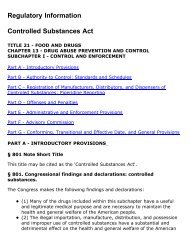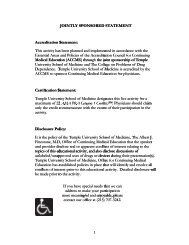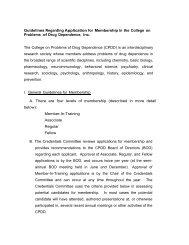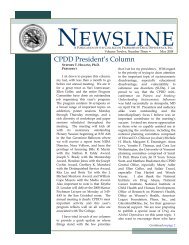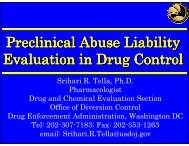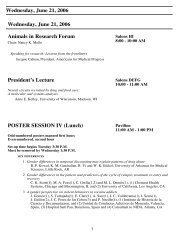CPDD 72nd Annual Meeting • Scottsdale, Arizona - The College on ...
CPDD 72nd Annual Meeting • Scottsdale, Arizona - The College on ...
CPDD 72nd Annual Meeting • Scottsdale, Arizona - The College on ...
Create successful ePaper yourself
Turn your PDF publications into a flip-book with our unique Google optimized e-Paper software.
117<br />
IMPLEMENTING RESEARCH IN TRADITIONAL<br />
COMMUNITY TREATMENT PROGRAMS: FINDINGS FROM<br />
A CTN TRIAL.<br />
Allan J Cohen 1 , D George 3 , c Langlois 1 , A Moreno 1 , D Yomjinda 3 , C Boubi<strong>on</strong> 3 ,<br />
J Martin 1 , R D<strong>on</strong>ovick 3 , C Vimieiro 1 , C Thomas 2 , A Hass<strong>on</strong> 2 , M Hillhouse 2 , W<br />
Ling 2 ; 1 Research/Training, Bay Area Addicti<strong>on</strong>, Research and Treatment, Inc.,<br />
San Francisco, CA, 2 ISAP, UCLA, Los Angeles, CA, 3 Matrix, Los Angeles, CA<br />
Aims: <str<strong>on</strong>g>The</str<strong>on</strong>g> disseminati<strong>on</strong> and adopti<strong>on</strong> of new evidence-based treatment into<br />
traditi<strong>on</strong>al treatment settings c<strong>on</strong>tinues to be fraught with many obstacles and<br />
challenges.<br />
<str<strong>on</strong>g>The</str<strong>on</strong>g> NIDA Clinical Trials Network was established to provide a mechanism for<br />
bridging the gap between research and practice, by c<strong>on</strong>ducting clinical trials<br />
research in community treatment programs (CTP), as well as to facilitate the<br />
adopti<strong>on</strong> of evidence-based treatment in these settings. An example is provided<br />
for this presentati<strong>on</strong> by a recently completed CTN project, “Starting Treatment<br />
with Ag<strong>on</strong>ist Replacement <str<strong>on</strong>g>The</str<strong>on</strong>g>rapies” (START; CTN 0027) designed to evaluate<br />
the hepatic safety of two medicati<strong>on</strong>s, Subox<strong>on</strong>e and methad<strong>on</strong>e, used in the<br />
treatment of opioid dependence. Discussed will be the organizati<strong>on</strong>al experiences<br />
of two of the eight participating CTPs, both affiliated with the CTN<br />
Pacific Regi<strong>on</strong>al Node; Bay Area Additi<strong>on</strong>, Research and Treatment (BAART)in<br />
San Francisco and Matirx Institute <strong>on</strong> Addicti<strong>on</strong>s in Los Angeles, in implementing<br />
a new evidence-based technology, Subox<strong>on</strong>e, into programs best<br />
described as “traditi<strong>on</strong>al methad<strong>on</strong>e” settings. Descripti<strong>on</strong>s of both programs<br />
their patients, organizati<strong>on</strong>al cultures and treatment philosophy, staff and<br />
research experience are presented. <str<strong>on</strong>g>The</str<strong>on</strong>g> presentati<strong>on</strong> will focus <strong>on</strong> individual and<br />
shared experiences including; study implementati<strong>on</strong>, recruitment and retenti<strong>on</strong><br />
challenges, study impact <strong>on</strong> existing program culture and the clincial and programatic<br />
benefits the study afforded, expanding patient access to treatment,<br />
increased staff and patient knowledge related to partial ag<strong>on</strong>ist treatment and<br />
and sustainability c<strong>on</strong>siderati<strong>on</strong>s.<br />
C<strong>on</strong>clusi<strong>on</strong>s: Clincial trials research can be successfully c<strong>on</strong>ducted in community<br />
treatment program settings and may facilitate the diffusi<strong>on</strong> and may serve in<br />
the adopti<strong>on</strong> of new treatments into traditi<strong>on</strong>al treatment programs.<br />
Financial Support: No financial support is associated with this presentati<strong>on</strong> or<br />
submissi<strong>on</strong>.<br />
119<br />
REPEATED ADMINISTRATION OF A LONGER ACTING<br />
MUTANT COCAINE ESTERASE: INTERACTIONS WITH THE<br />
ACUTE CARDIOVASCULAR EFFECTS OF COCAINE AND<br />
IMMUNE RESPONSES IN FREELY MOVING RHESUS<br />
MONKEYS.<br />
Gregory T Collins, D Narasimhan, K A Carey, A A Berlin, N W Lukacs, R K<br />
Sunahara, J H Woods, M C Ko; University of Michigan Medical School, Ann<br />
Arbor, MI<br />
Aims: Cocaine (COC) is the most comm<strong>on</strong> illicit drug related to emergency<br />
room visits, with the majority of cases due to chest pain resulting from increases<br />
in blood pressure (BP) and heart rate (HR). <str<strong>on</strong>g>The</str<strong>on</strong>g>se studies were aimed at characterizing<br />
1) the capacity of a mutant COC esterase (T172R/G173Q; DM CocE)<br />
to ameliorate the cardiovascular effects of COC, and 2) the development of anti-<br />
CocE antibodies following repeated dosing with DM CocE in rhesus m<strong>on</strong>keys.<br />
Methods: Four rhesus m<strong>on</strong>keys (2 male and 2 female) were implanted with telemetric<br />
probes (DSI; D70-PCT) capable of c<strong>on</strong>tinuous measurement of BP and<br />
HR. DM CocE (0, 0.032, 0.1, 0.32, 1.0, or 3.2 mg/kg; IV) was administered 10<br />
min after an IV dose of 3.2 mg/kg (n=3), or 1.0 mg/kg (n=1) COC, with BP and<br />
HR recorded for an additi<strong>on</strong>al 110 min. Blood was collected 24h prior to test<br />
sessi<strong>on</strong>s to allow for anti-CocE antibody titer determinati<strong>on</strong>s.<br />
Results: In general, IV COC resulted in persistent increases in BP and HR. DM<br />
CocE produced dose-dependent and rapid decreases in BP in all four m<strong>on</strong>keys,<br />
with BP returning to c<strong>on</strong>trol levels within the first 5-10 min following doses of<br />
0.32, 1.0, or 3.2 mg/kg DM CocE. Similar decreases in HR were observed in 3<br />
of the 4 m<strong>on</strong>keys, although these changes occurred over a l<strong>on</strong>ger time course.<br />
Repeated dosing of DM CocE failed to produce significant increases in anti-<br />
CocE antibody titers.<br />
C<strong>on</strong>clusi<strong>on</strong>s: <str<strong>on</strong>g>The</str<strong>on</strong>g>se studies dem<strong>on</strong>strate that DM CocE is capable of producing<br />
a rapid, and robust ameliorati<strong>on</strong> of COC-induced elevati<strong>on</strong>s in BP, and to a lesser<br />
degree HR, in rhesus m<strong>on</strong>keys. In additi<strong>on</strong>, the effectiveness of DM CocE to<br />
reverse the cardiovascular effects of COC was unaffected by repeated dosing, and<br />
occurred in the absence of significant immune resp<strong>on</strong>ses. Together, these results<br />
suggest that DM CocE may provide a novel and effective therapeutic for the<br />
treatment of acute COC toxicity.<br />
Financial Support: NIDA grants DA023213 & DA021416<br />
<str<strong>on</strong>g>CPDD</str<strong>on</strong>g> <str<strong>on</strong>g>72nd</str<strong>on</strong>g> <str<strong>on</strong>g>Annual</str<strong>on</strong>g> <str<strong>on</strong>g>Meeting</str<strong>on</strong>g> <str<strong>on</strong>g>•</str<strong>on</strong>g> <str<strong>on</strong>g>Scottsdale</str<strong>on</strong>g>, <str<strong>on</strong>g>Ariz<strong>on</strong>a</str<strong>on</strong>g><br />
30<br />
118<br />
DISTRESS TOLERANCE AND ADOLESCENT SMOKING<br />
CESSATION.<br />
Anahi Collado-Rodriguez, W Francis, K Young, J Gottlieb, C W Lejuez, L<br />
MacPhers<strong>on</strong>; University of Maryland - <str<strong>on</strong>g>College</str<strong>on</strong>g> Park, <str<strong>on</strong>g>College</str<strong>on</strong>g> Park, MD<br />
Aims: More than half of adolescent smokers report attempts to quit each year<br />
(YRBS, 2005; Riedel et al., 2002) but <strong>on</strong>ly a small percentage actually succeed<br />
(Moss, Allen, Giovino & Mills, 1992; Zhu et al., 1999). In efforts to understand<br />
the underlying reas<strong>on</strong>s for failed cessati<strong>on</strong> attempts, the current study investigated<br />
negative emoti<strong>on</strong>ality and resulting avoidant coping styles, specifically distress<br />
intolerance, as a c<strong>on</strong>tributing factor to relapse. Low psychological distress<br />
tolerance is defined as the inability to persist in goal-directed behavior in the face<br />
of affective distress and has predicted poor cessati<strong>on</strong> outcomes am<strong>on</strong>g adult<br />
smokers.<br />
Methods: <str<strong>on</strong>g>The</str<strong>on</strong>g> study is currently in the data collecti<strong>on</strong> process. <str<strong>on</strong>g>The</str<strong>on</strong>g> available<br />
sample c<strong>on</strong>sists of 22 adolescent daily smokers who reported a desire to quit<br />
smoking within 30 days up<strong>on</strong> enrollment (mean age =16.8, 57.1% male, 61.9%<br />
White, mean cigarettes per smoking day (CPSD) = 8.7). Outcome variables were<br />
assessed during baseline, quit date, and at 7-day intervals over the period of a<br />
m<strong>on</strong>th post-quit date. Psychological distress tolerance in the current study was<br />
measured using computer-based behavioral tasks, including the Mirror Tracing<br />
Persistence Task (MTPT) and the Paced Auditory Attenti<strong>on</strong> Serial Task<br />
(PASAT).<br />
Results: To date, 82% of participants reported making a quit attempt (mean<br />
durati<strong>on</strong> = 15.6 days) and 91% of participants indicated a reducti<strong>on</strong> of CPSD.<br />
Lower distress tolerance was associated with younger age of smoking <strong>on</strong>set, higher<br />
baseline CPSD, and heaviest lifetime smoking. Prospective analyses indicated<br />
that lower distress tolerance predicted shorter quit attempt durati<strong>on</strong> and smaller<br />
reducti<strong>on</strong>s in CPSD across the follow-up period, after accounting for baseline<br />
smoking.<br />
C<strong>on</strong>clusi<strong>on</strong>s: Preliminary results of the current study elucidate processes that<br />
may predispose adolescents to fail in their smoking cessati<strong>on</strong> attempts. Low psychological<br />
distress tolerance should be c<strong>on</strong>sidered as a basic mechanism to target<br />
in smoking cessati<strong>on</strong> treatments for adolescents.<br />
Financial Support: NIDA K23 DA23143<br />
120<br />
DRUG-SEEKING IN RESPONSE TO A PRIMING INJECTION<br />
OF MDMA IN RATS: RELATIONSHIP TO INITIAL<br />
SENSITIVITY TO SELF-ADMINISTERED MDMA AND<br />
DORSAL STRIATAL DOPAMINE.<br />
Joyce Colussi-Mas, R J Wise, S Schenk; School of Psychology, Victoria<br />
University of Wellingt<strong>on</strong>, Wellingt<strong>on</strong>, New Zealand<br />
Aims: In laboratory animals, exposure to priming injecti<strong>on</strong>s of 3,4-methylenedioxymethamphetamine<br />
(MDMA) produced drug seeking following extincti<strong>on</strong><br />
of MDMA self-administrati<strong>on</strong>. <str<strong>on</strong>g>The</str<strong>on</strong>g> present study aimed to evaluate whether the<br />
magnitude of drug seeking was related to latency to acquisiti<strong>on</strong> of MDMA selfadministrati<strong>on</strong><br />
and increases in striatal dopamine.<br />
Methods: Rats (n=23) were given daily access to MDMA self-administrati<strong>on</strong><br />
until they earned a total of 240 infusi<strong>on</strong>s (total intake of 165 mg/kg MDMA).<br />
An additi<strong>on</strong>al group of rats (n=7) were yoked to some of the rats that self-administered<br />
MDMA so that they passively received the same amount of MDMA. Two<br />
days later, drug-seeking tests were c<strong>on</strong>ducted and all animals received a MDMA<br />
(10.0 mg/kg, i.p.) priming injecti<strong>on</strong> while changes in extracellular dopamine in<br />
the dorsal striatum were measured by in vivo microdialysis.<br />
Results: Fourteen of the 23 rats acquired self-administrati<strong>on</strong> within the temporal<br />
limits of the study and the latency to meet the criteri<strong>on</strong> ranged from 9-37<br />
days. An experimenter administered injecti<strong>on</strong> of MDMA produced drug seeking<br />
in these rats, and the number of resp<strong>on</strong>ses was significantly higher than resp<strong>on</strong>ses<br />
produced by rats that failed to meet the criteri<strong>on</strong> or by yoked c<strong>on</strong>trol rats. For<br />
rats that met the criteri<strong>on</strong>, drug seeking was negatively correlated with the number<br />
of days to self-administer the criteri<strong>on</strong> number of MDMA infusi<strong>on</strong>s and positively<br />
correlated with MDMA-produced dopamine in the dorsal striatum.<br />
Importantly, MDMA-produced dopamine overflow was greater for the rats that<br />
met the criteri<strong>on</strong>.<br />
C<strong>on</strong>clusi<strong>on</strong>s: <str<strong>on</strong>g>The</str<strong>on</strong>g>se findings suggest that drug seeking is influenced by initial<br />
sensitivity to the reinforcing effects of MDMA and related to drug-produced<br />
increases in striatal dopamine.<br />
Financial Support: Neurological Foundati<strong>on</strong> of New Zealand and Wellingt<strong>on</strong><br />
Medical Research Foundati<strong>on</strong>.




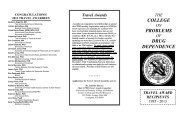
![2013SYMP AND WORKSHOP LIST[web]](https://img.yumpu.com/35325424/1/190x245/2013symp-and-workshop-listweb.jpg?quality=85)
